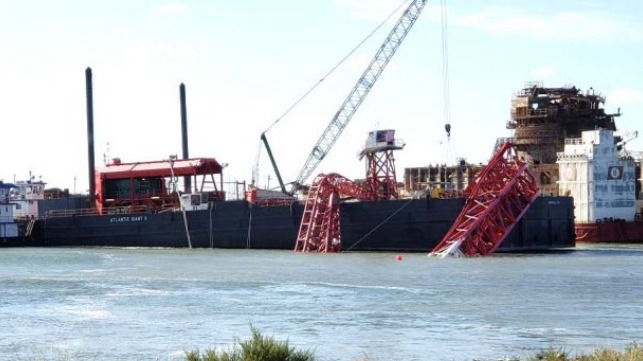
On August 9, 2018, about 2030 local time, the main boom on the crane barge Atlantic Giant II failed while moving a section of a vessel being dismantled in the Brownsville Ship Channel in Brownsville, Texas. The load and crane boom subsequently fell into the harbor. Two shipyard employees working on the barge were injured as well as a third on board an assisting tugboat. No pollution was reported. Damage to the barge and crane amounted to an estimated $6.4 million.
The 225-foot Atlantic Giant II was built at the Keppel AmFELS shipyard in 2014 for its affiliate, South Coast Maritime Corporation (SCM). On the day of the accident, the vessel was contracted to assist with ship-breaking operations at the SteelCoast facility.
The NTSB states that the probable cause of the failure was the decision by SCM and SteelCoast to continue with a lift that exceeded the planned weight without conducting additional risk assessments for the continuation of work as the crane neared its maximum capacity.
Keppel AmFELS’ internal investigation of the crane failure determined that when the spuds were retracted to move the Atlantic Giant II, the crane was affected by additional factors: including “wind, wave action, and drifting action.” These factors resulted in the suspended counterweight shifting to starboard, thereby sideloading the crane boom. Because the suspended load was not centered below the boom, the crane collapsed to the starboard side of the barge.
The crane operator stated that he boomed up to 69 or 70 degrees; the Keppel AmFELS’ incident report stated 68 degrees. Therefore, the vessel would have trimmed at least seven degrees by the stern—hence the 1.5 foot of air gap the tugboat captains witnessed at the barge’s end opposite of the crane—for the boom angle to read 60.7 degrees when the weight was suspended. At 60.7 degrees of boom angle, the maximum capacity of 645 tons was exceeded by 26 tons.
After the accident, SCM issued additional internal guidelines for crane barge lifting operations that call for more detailed weight, structural and stress information from clients. Ballasting and stability information was not included in the job risk analysis or lift plan.
Although SCM stated that the Atlantic Giant II was always ballasted for its maximum load of 700 tons, no additional ballasting was completed when the load was discovered to be heavier, nor were any stability calculations completed, including longitudinal center of gravity and expected trim, states the NTSB.
The first lift, the A-frame, made by the Atlantic Giant II was almost double the planned weight, yet work proceeded with the next much heavier lift. There were numerous opportunities for employees to stop the work, including the times when the lift was initially at 400 tons, then increased to 500 tons, and later to 550 tons of tension—yet none of those attempts moved the load.
The deviation from the planned 350 tons communicated by the client was not immediately investigated to determine the source of the discrepancy. Furthermore, there was no discussion that the 75 percent of the maximum lift (525 tons) indicated on the job risk analysis form had been exceeded. Similarly, the tugboat captains’ reports of Atlantic Giant II’s stern coming clear of the water went unanswered.
The report is available here.

Comments
Post a Comment